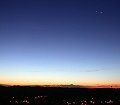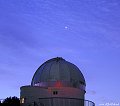|
Summary: July 13, 2001, marked
the beginning of a month-long planet show for stargazers. Jupiter,
Venus, Saturn, Mercury, the Moon and a giant red star named Aldebaran
have participated in a dazzling series of conjunctions before
dawn this month and last. The latest close encounter on August
5th and 6th was between Jupiter and Venus -- the two brightest
planets. See "Morning
Coffee and Planets" for more information.
Unless
otherwise stated, all images are copyrighted by the photographers.
|
|
Photographer, Location, Date |
Larger images |
Comments |
 |
Mike Klensch,
Skagway, Alaska
August 13, 2001 |
#1, #2,
#3, #4,
#5, #6,
more |
M. Klensch: "We finally have enough darkness
[in Alaska] to see the stars and aurora. I was watching the morning
planets and looking for Perseid meteors on Aug. 13 when I spotted
my first auroras of the new season." |
 |
Dennis
Mammana, Southern Calif.
August 12, 2001 |
#1, more |
D. Mammana: "Venus & Jupiter shine over
the eastern horizon as the first light of dawn illuminates Mt.
Laguna in Southern California." Photo details: Eight second
exposure at 5:21 a.m., shot with a Canon 85mm f/1.2 lens (at
f/2.8) on Kodak 100VS film. " |
 |
Duane
Clausen, Menominee,MI
August 7, 2001 |
#1, #2,
more |
Photo details: 200 speed film, 28mm lens @ 1.8,
30 second exposures. Photo #2
shows the Pleiades above the grain silo. |
 |
Marie-Georges
Bélanger and
Sébastien Giguère, Mount Megantic, Quebec,
Canada,
August 5, 2001 |
#1, #2,
#3, #4,
#5, #6,
#7 |
These breathtaking photos were captured at the
Mount-Megantic Popular Observatory,
near the border between Quebec and New Hampshire. |
 |
Mark
S Deprest, Ann Arbor, MI
August 5, 2001 |
#1 |
The full-sized
version of this starry photo shows Jupiter and the Galilean
satellites (top to bottom Callisto, Ganymede, Io and Europa)
along with brilliant Venus. Photo details: Pentax 35mm manual
camera at the prime focus of a 5" f/5 homebuilt Jaegers
refractor. 2 min. exposure on Fujicolor 400 Superia film. |
 |
Schindler
Leung & Howard Ho, Hong Kong, Aug. 5, 2001 |
#1 |
This dazzling image of the Moon was captured
at the Space Observers' Yuen Long Observatory in Hong Kong. Photo
details: Exposure: 1/125 F/3.9; ISO: 112; telescope: Vixen 102mm
Refractor w/o ED; eyepiece: Meade Super Possel 26 mm; Mount:
Vixen GP; Camera: Nikon Coolpix 950 |
 |
Thad V'Soske,
San Diego, CA, July 19, 2001 |
#1, #2 |
Thad captured photo #1
at 5 am on July 19th along Sunrise Hwy in Mt. Laguna California
using Kodak E100VS film; 12 sec exposure; 50mm lens at f/5.6.
Photo #2 shows the planets
on July 17th, captured using Kodak E100VS film; 8 sec exposure;
135mm lens at f/5.6. |
 |
Mark
S Deprest, Ann Arbor, MI
July 17, 2001 |
#1 |
This photo entitled "Busy Morning"
shows, from top to bottom, an airplane trail, The Pleiades, Saturn,
The Moon, Venus, Aldeberan, The Hyades, another airplane trail
and a street light. Photo details: Pentax 35mm manual camera,
35mm f/3.5 wide angle lens, tripod-mounted, 20 sec exposure with
Fujicolor 800 Superia X-Tra film. |
 |
Camilla Bacher,
Boulder, CO, July 15, 2001 |
#1, more |
This photo shows Saturn and Venus during their
close conjunction on July 15th with the International Space Station
streaking by. |
 |
Dirk Obudzinski,
Joshua Tree National Park, USA July 17, 2001 |
#1, #2, #3,
more |
Photo #3
shows Jupiter and Mercury very near the horizon. See if you can
spot Mercury. Photo details: Nikon EM Camera, 50mm lens, f/2.0,
6 to 12 sec. exposures on Kodak Royal Gold 400 film. |
 |
Dominic
Cantin, Quebec, Canada,
July 26, 2001 |
#1 |
The thumbnail doesn't do justice to this picture.
The full-sized version reveals
Jupiter, Venus, Saturn and the streaking International Space
Station! Photo details: 35mm@f/4; 25 seconds; fuji superia 800 |
 |
Leonard Lakey,
Wichita, Kansas, USA
Aug. 5, 2001 |
#1 |
L. Lakey: "Two planets (Jupiter and Venus)
and three moons? I took this picture using my Olympus D-510 set
for 0.5 second exposure with fill-in flash. The flash illuminated
the tree leaves but also created the phantom moons." |
 |
Chris
Grohusko, El Paso, Texas , Aug. 6, 2001 |
#1, #2 |
These photos show brilliant Jupiter and Venus
-- bright enough to distract driver sfrom road signs and street
lights. Photo details: 50 mm Pentax 1.7 lens stopped to f/2.8
on Fuji Super G 800 Film on Manual Setting; Pentax P3 Camera
on Tripod with Throat Auto Lock Cable Release. 30-60 sec exposures. |
 |
Schindler
Leung & Howard Ho, Hong Kong, Aug. 5, 2001 |
#1, #2 |
These images of Jupiter and Venus were captured
at the Space Observers' Yuen Long Observatory in Hong Kong. Photo
details: Exposure: 1s F/2.6; ISO: 320 -0.3 EV; Focal Length:
7.2 mm; Camera: Nikon Coolpix 950 |
 |
Stan Richard,
Des Moines, Iowa,
August 6, 2001 |
#1, #2,
more |
S. Richard "You will notice the star mu
Geminorum right between Jupiter and Venus in these photos, very
neat. I used Fuji Superia 800 film for these 2 shots, 70mm at
f/4 & 420mm
at f/8." |
 |
Joe
Wheelock, UT McDonald Observatory, near Ft. Davis, Texas,
August 6, 2001 |
#1 |
J. Wheelock captured this picture of Jupiter
and Venus using an Olympus C-2020 zoom digital camera. The
dome is that of the 82" Otto Struve Telescope. The constellation
Orion is also visible in the full-sized
version. Photo details: 16 sec. exposure at f/2 |
 |
Jimmy
Westlake, Yampa, Colorado, July 17, 2001 |
#1, #2 |
J. Westlake captured these photos of the July
17, 2001 grouping of the waning crescent moon and planets Venus,
Saturn, and Jupiter. Photo details: Nikon FE-2, 10 second exposure,
Kodak Max 400 film. Photo #1
50 mm lens @ f1.8, photo #2
210 mm lens @ f4.0. |
 |
Joe
Orman, Phoenix, AZ, July 19, 2001 |
#1, more |
This beautiful photo by Joe Orman shows a pre-dawn
close encounter between Earth's moon and mercury. The scene was
captured by Joe in Phoenix, Arizona using Fuji Provia 100 slide
film with Olympus OM-1 35mm camera on fixed tripod, scanned with
Nikon Coolscan LS-10E. |
 |
Tom A.
Warner, Rapid City, SD, USA
Aug. 5, 2001 |
#1, #2,
#3 |
The two bright "stars" are Jupiter
and Venus. Photo details: Nikon Coolpix 995 digital camera. |
 |
Stefan Stumpf,
Germany,
Aug. 6, 2001 |
#1, #2 |
These pictures feature Jupiter, Venus, Saturn
and the red star Aldebaran. Click for a labeled
photo. Photo Details: Olympus C2020Z digital camera. Exposure:
2 - 4 sec. Focal length 35mm - 105mm. |
 |
Stan Richard,
Des Moines, Iowa,
July 15, 2001 |
#1, more |
S. Richard "Here's a shot I took of the
closest conjunction of Venus & Saturn, 0.7 degrees apart
on July 15, 2001. In the foreground is the Drake Municipal Observatory
in Des Moines, Iowa." |
 |
Rick Stankiewicz,
Peterborough, Ontario, Canada, July 12 - 19, 2001 |
#1, #2, #3,
#4, #5 |
Photographer Rick Stankiewicz captured a week-long
series of planetary conjunctions described in the Science@NASA
article "Morning
Coffee and Planets." Photos: #1
July 15th; #2 July 14th;
#3 July 16th; #4
July 19th; #5 no planets
but a beautiful sunrise on July 12th. |
 |
Geoff
Sims, Sydney, Australia,
July 16, 2001 |
#1 |
Photo details: Nikon F70 camera, Fuji Superia
400 film, f/3.5. |
 |
Waldemar Villamayor
Venialbo, Asunción, Paraguay
Aug 6, 2001 |
#1 |
Venus and Jupiter appear among the colorful pink
clouds of dawn. Photo details: EPSON PhotoPC 650 (digital camera) |
 |
Gregg Thomas,
Oswego, New York
Aug 5, 2001 |
#1 |
The two bright "stars" in this picture
are Jupiter and Venus. Photo details: Kodak DC3200 Digital Camera |
 |
Mark Cunningham,
Craig, CO, July 17, 2001 |
#1 |
Photo details: 50mm lens f2.8, 200asa Fuji film
for 30 sec. Saturn, Moon, Aldebaran, Venus appear in the upper
right corner. Jupiter and Mercury are in the lower left. |
back
to spaceweather.com |

























